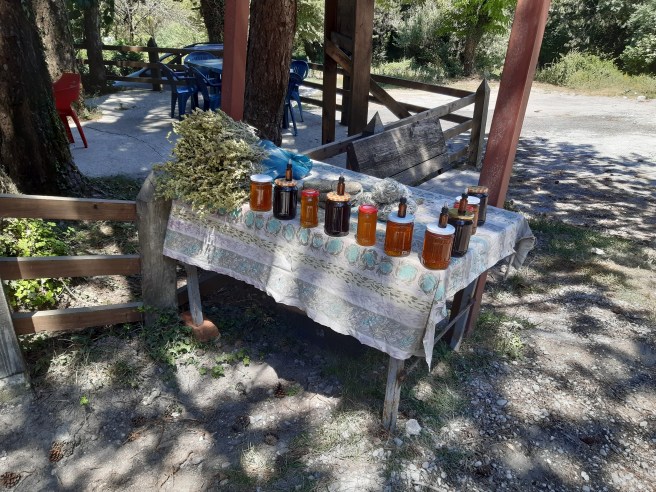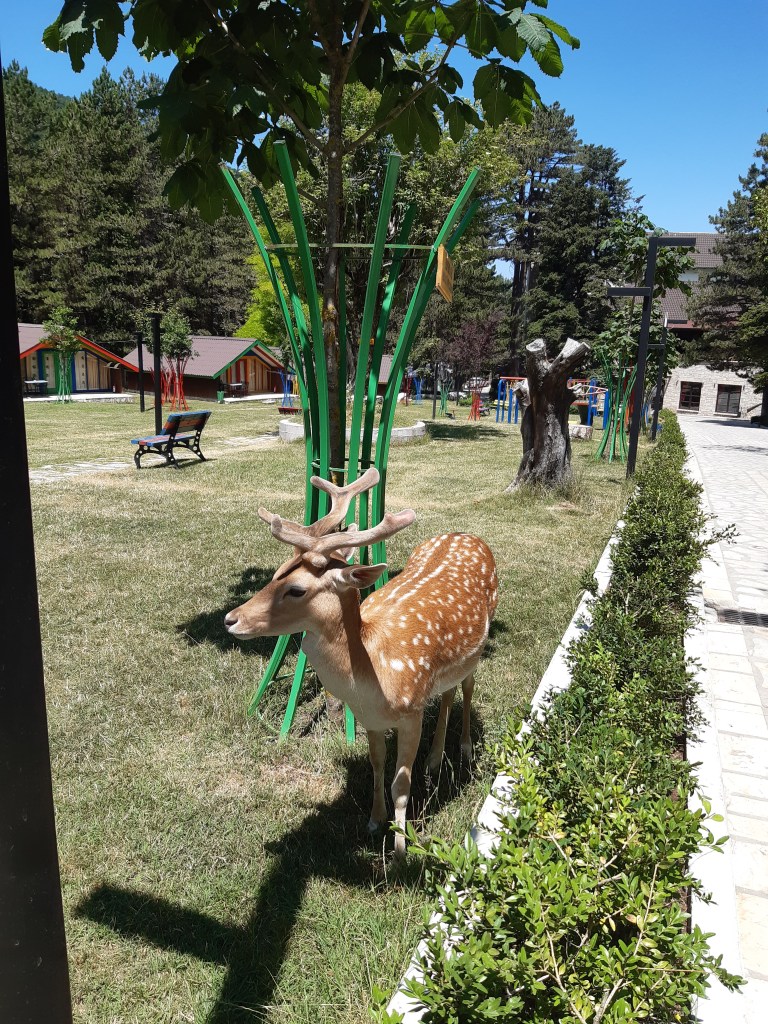Driving from Tirana to Vlora and its Coast takes about 2 hours.
The first association to come to an Albanian’s mind when Vlora is mentioned is the city’s link with the proclamation of the Independence of Albania in 1912. Vlora has always been on my mind with the pictures that I remember from my childhood history book. A bunch of great bearded Albanian patriots who assembled on a tiny balcony of a house in Vlora on a certain day of November declaring the independence from the Ottomans, trying to save what could be saved from the Albanian territories. The desire to see the House of Independence drove my family and I from Tirana to Vlora on a beautiful Saturday last June. We could not visit the House of Independence as the square around it was being renovated. I wanted to look at that balcony from my childhood mind in an attempt to see the patriots again. I was sure they were no longer there and I was sure they would always remain in my mind’s eyes as black and white photos.
At dusk, we left Vlora, the third largest city of Albania on its way to become a place of balneary tourism of predilection for all Albanians whether in or out of the country. We will remember its main vibrant boulevard recently renovated with modern street lights and newly planted trees with lots of people going out on a typical Mediterranean evening walk with a breeze. We could barely hear any foreign language spoken showing that city was not still invaded by foreign tourists.
The night was coming and we headed to Fiori’s Apartments. The place was recommended to us by our French friends who had been staying in Albania for two years. It was a very beautiful 135 square meter apartment in a setting of dozens of other apartments with simple and modern design with a swimming pool in the compound.
In front of the property was a little beach where you could go for a swim or you can also frequent the very beautiful uncrowded beaches next to the Hotel Liro or the Beach of Kalaja.
The owner’s daughter Michele with blue eyes like the sea of her city was kind and pleasant. She told us about the nearby beaches and the places to visit in Vlora. She explained to us about the island of Sazan, a submarine base for the Germans and Italians, that was subsequently bombed by the allies during the Second World War, to later become a base for Soviet submarines during the political relationship between Albania and the Soviet Union. She also recommended a visit to the peninsula of Karaburun surrounded by both the Adriatic and the Ionian Seas and she also told us about of the monastery of Zvrnec.
Her father Kristofor, who was a long line truck driver with a difficult life, boasted his Greek origin telling us how he and his extended family took back his family’s traditional property after the fall of the communism state. He had stressed how his father never accepted a penny of the regime which tried to take his land for nothing. It was on that property that he and his cousins had made the beautiful small resort.
Next morning we drove from Vlora to Orikum along the cost. That part of the Albanian seaside is beautiful with both rocky and sandy beaches with surrounding grey-green mountains overlooking the sea. The road had many hotels, apartments and rooms which you can easily rent through booking.com or airbnb, etc.
I could never imagine Albania so dynamic and vibrant! No country and people can be prouder of catching up with lost time than the Albanians, for no country and people in the region has gone through such an anti-humane regime as the Albanians have.
I love Albania! I have always loved it.
We only passed by the town of Orikum but did not stay in this ancient coastal city. We read that the city was the scene of a key event in the conquest for absolute power by Julius Caesar in the civil war with Pompey. It is said that when communism was introduced into the country during the second half of the 20th century the regime had prevented archaeologists and historians from approaching this unique site. Albania had to wait until 2008, when the Swiss and Albanian archaeologists initiated their first excavations. It is a city that has so far only revealed very few of its mysteries.
With these thoughts and our restless kids in our red car we headed up towards the mountain of Llogara whose descent would lead us again to the beautiful seaside. Along the winding road were several restaurants, hotels and a complex of small wooden cabins for tourists. We could see several local suppliers of honey and mountain tea selling their local products by the roadside. We stopped and pulled over for a break at the highest point of this refreshingly green National Park with pine trees dancing and bending on the breeze of the fresh wind! We just could not sense that a few miles away the opposite of that landscape was awaiting us!



We met there our Indian friends from Tirana, who happened to be be there the same day, staying in the Tourist Village of Llogara, one of the best known hotels in the area. They told us about their hiking in the mountains with a local guide who told them of a hiking trail called the Passage of Caesar named after Julius Caesar, who had walked near the area in pursuit of his rival Pompey. According to a waiter serving in one of the restaurants, Llogara was historically known to be a holiday and entertainment area for Albanians during communism. The other well-known places to stay were Sofo Hotel and the Alpine Hotel.
We set off again being resolute to go further on our trip even though we were tired! We wanted to see the sea one more time. We had heard so much about that part of the coast.
From the top of Llogara, all of sudden we found ourselves driving on the serpentine road of a slope facing down to the Dhermi beaches. We stopped again. It was on a platform, a sort of landing, where there were many tourists and lovers were taking pictures of the places and of themselves hugging each other in front of the endless sea. I exited the car. The beautiful desolation of the blue sea was in front of me. The sea and the sky were like two lovers embracing each other with their nuances of blue in the melancholy. How much beauty was in front of that sea being there forever with the arid mountains behind! The Earth revealed to me for the first time as rounded.



We drove slowly down the road approaching Dhermi, a village at the foot of the mountain facing the sea. At some places wild, at some other places very touristic, Dhermi was in transition between past and modernity! Very seductive, Dhermi invited us to visit its old town, charming with its small peaceful streets, its churches, so silent in the hot day of June.
We finally ended up on a beach surrounded by restaurants serving a delicious food in company of few local and foreign tourists. The latter seemed to me having been lost and astray in a country which was little known to the people of the other world. I wondered how two young Spanish lovers ended up here? What adventure had they embarked on to this previously unknown part of Europe?

Thank you for reading my blog!
Much love,
Arta 🦋
Really amazing city
LikeLiked by 1 person
Thank you
LikeLike
Hi, Arta! Thank you for following LeightonTravels.
It is lovely to see the beautiful pictures of Albania and read about its history. We are planning to embark on a great Balkan travel adventure some day, so I’m sure we’ll get a lot of inspiration from your blog.
Looking forward to exploring Albania with you.
LikeLiked by 1 person
Great! I am sure you will love Albania and the Balcans. Thank you for following my blog too. Best regards, Arta
LikeLiked by 2 people
Hello Arta I have never seen so many awesomely beautiful pictures of Albania before in my life. Your country is stunning as you can see the curve of the earth from that last beach at the bottom of the mountain. Your blog is a very unique blend of old and new which stands out so fascinating to my eyes and my mind. I will come back and read and look to enjoy the pictures you provide for us. Thank you and nice to meet you Arta. I am James Best
LikeLike
Thank you so much for your kind words 😊 best regards from Albania
LikeLiked by 1 person
You are welcome and your warm words mean a lot from Western Canada Arta
LikeLike